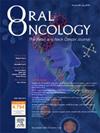Development of a novel prognostic signature derived from super-enhancer-associated gene by machine learning in head and neck squamous cell carcinoma
Abstract
Dysregulated super-enhancer (SE) results in aberrant transcription that drives cancer initiation and progression. SEs have been demonstrated as novel promising diagnostic/prognostic biomarkers and therapeutic targets across multiple human cancers. Here, we sought to develop a novel prognostic signature derived from SE-associated genes for head and neck squamous cell carcinoma (HNSCC). SE was identified from H3K27ac ChIP-seq datasets in HNSCC cell lines by ROSE algorithm and SE-associated genes were further mapped and functionally annotated. A total number of 133 SE-associated genes with mRNA upregulation and prognostic significance was screened via differentially-expressed genes (DEGs) and Cox regression analyses. These candidates were subjected for prognostic model constructions by machine learning approaches using three independent HNSCC cohorts (TCGA-HNSC dataset as training cohort, GSE41613 and GSE42743 as validation cohorts). Among dozens of prognostic models, the random survival forest algorithm (RSF) stood out with the best performance as evidenced by the highest average concordance index (C-index). A prognostic nomogram integrating this SE-associated gene signature (SEAGS) plus tumor size demonstrated satisfactory predictive power and excellent calibration and discrimination. Moreover, WNT7A from SEARG was validated as a putative oncogene with transcriptional activation by SE to promote malignant phenotypes. Pharmacological disruption of SE functions by BRD4 or EP300 inhibitor significantly impaired tumor growth and diminished WNT7A expression in a HNSCC patient-derived xenograft model. Taken together, our results establish a novel, robust SE-derived prognostic model for HNSCC and suggest the translational potentials of SEs as promising therapeutic targets for HNSCC.

 求助内容:
求助内容: 应助结果提醒方式:
应助结果提醒方式:


